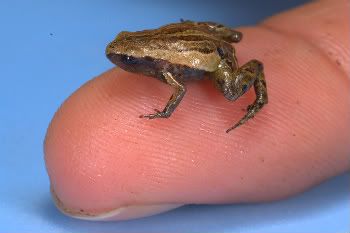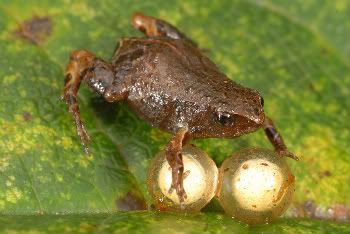The tiny frog took biologists by surprise since as a general rule species in higher altitudes tend to be larger than similar species in lower regions. Measuring at less than half an inch, the Noble's pygmy frog is not only the smallest frog in the Andes, but one of the smallest vertebrates in the world above 3,000 meters.
Unlike most of her relatives the female Noble's pygmy frog lays eggs that hatch not tadpoles, but actual infant frogs. Instead of laying hundreds of eggs, she lays only two in a moist place, like under moss or the leaf litter. The mother protects the eggs from drying out and hungry insects.
The status of the Noble's pygmy frog population is unknown, however the chytrid fungus that has devastated amphibians globally has also taken its toll in Peru. Herpetologists hope the nature of the ecosystems in the Andes allows endangered frogs places to retreat to avoid the plague.

Male Noble's pygmy frog on index finger.

Female Noble's pygmy frog attending her two eggs.
The frog was discovered in the cloud forests of Manu National Park in Peru. The frog inhabits cloud forest, montane scrub, and the high-elevation grasslands located in the park and the privately-owned Wayqecha Research Station. Ten new frog species have been discovered in these cloud forests in the last two years alone.
The new species is described by Edgar Lehr from the Senckenberg Natural History Collections in Dresden and Swiss-Peruvian ecologist Alessandro Catenazzi from the University of California at Berkeley in the latest issue of the journal Copeia.
Citation: Lehr, E., and A. Catenazzi. 2009. A new species of minute Noblella (Anura: Strabomantidae) from southern Peru: the smallest frog of the Andes. Copeia 2009(1): 148-156.
resource: news.mongabay.com





No comments:
Post a Comment